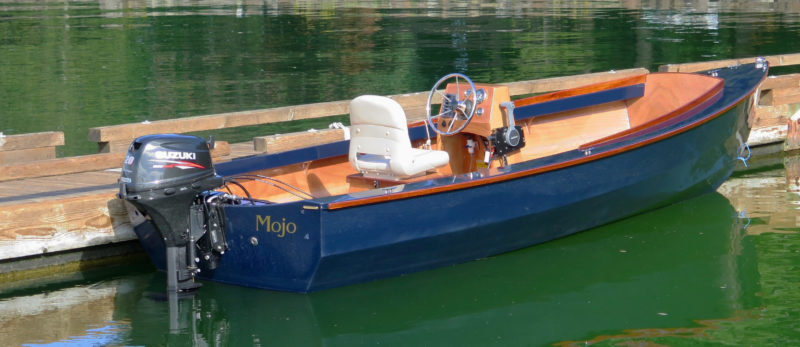 photographs courtesy of the author
photographs courtesy of the author“That boat is so damned beautiful, it’s making the rest of us look bad.”
Mark Ramsby of Portland, Oregon, wanted a bigger boat. He had built a cedar-strip canoe and had used it for several years, but at 66 he was finding it more difficult to sit in its confines of long stretches of time. After he had retired he thought about building a boat with enough room and stability for him to move about and to take on less-sheltered waters: the lower Columbia River, Puget Sound, Hood Canal, and the San Juan Islands to the north in Washington State.
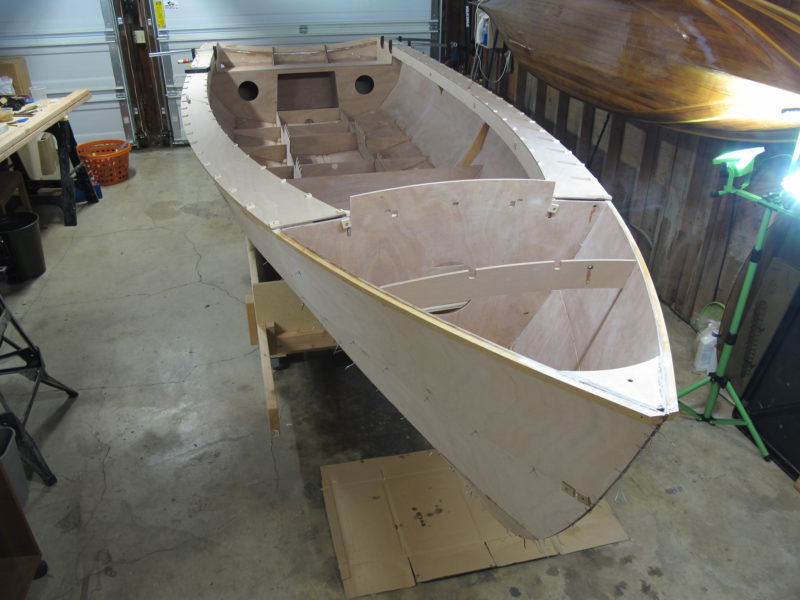
CNC-cut tabs, slots and notches assured a fair and symmetrical hull.
Mark looked at a wide variety of designs for powerboats and sailboats. While he was interested in boats up to 30′, his home workshop in his two-car garage set the limit at 20′. He opted for a powerboat to travel without the limitations often posed by sail, and briefly considered a boat with sleeping arrangements for overnight trips with his wife, Meg. To keep the boat simple, affordable, and versatile, he decided that shore-side accommodations—camping on the beach or renting a room—were the better option.
Harry Bryan’s 18′ Handy Billy caught his eye, and he went so far as to buy the plans and loft the lines. The 5′ beam began to look too small, the projected 900-lb weight too heavy, and the potential for leaks in the batten-seam construction too great. He abandoned the project and went back to his search.
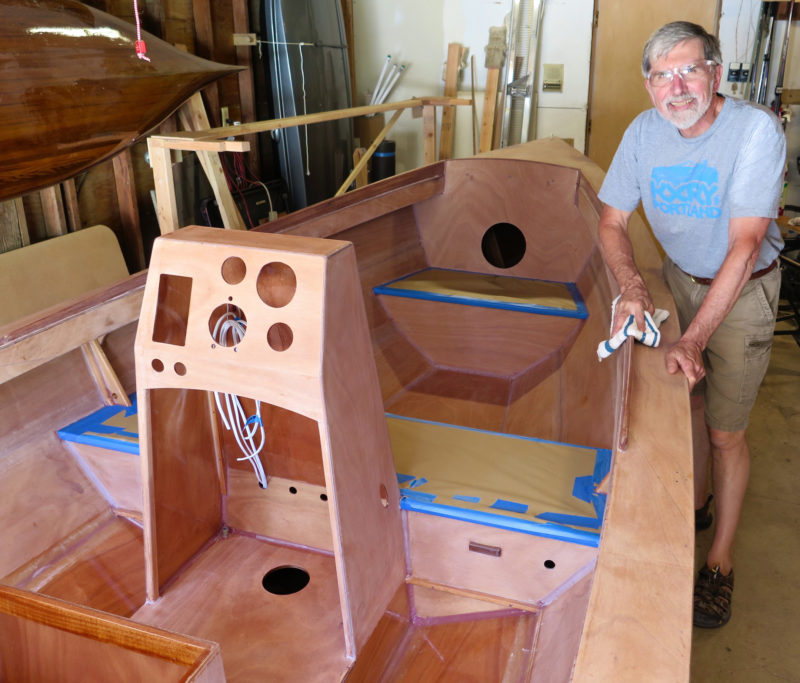
After Mark finished building the boat, he got it prepped for a professional painter to apply the finish.
Mark had seen PT Watercraft’s 18′5″ PT Skiff in Port Townsend, Washington. With a weight of 385 lbs (without motor), this center-console runabout was much lighter than the Handy Billy, wider at 6′2″, and, with its plywood and fiberglass construction, wasn’t going to leak after drying out while sitting on a trailer in his garage. Mark wanted the experience of building from plans, but the PT skiff was available only as a kit. After considering the building time—2,000 hours for the Handy Billy versus 400 hours for the PT skiff—the kit became the obvious choice. “That was the difference between building it over a couple of years and building over the winter. Since I was 66 at the time and wanted to use this boat, I wrote the check and placed my order.”
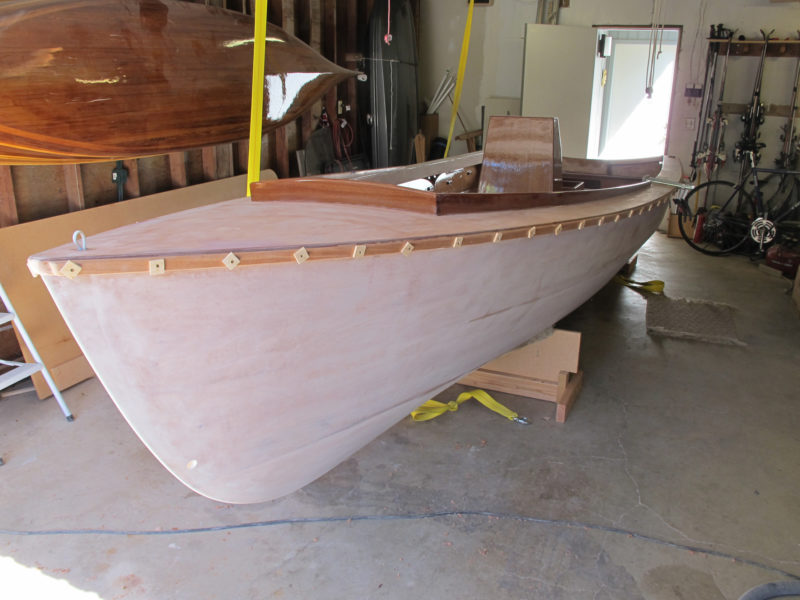
Anticipating he’d varnish the outwales, Mark glued them using small square pads of plywood to minimize the damage the temporary screws would do.
The CAD-designed kit parts are CNC-cut from BS 1088 okoume plywood with tabs and slots, puzzle joints, scribed markings, and alignment notches to assure everything gets assembled with great precision. Mark made a number of modifications to his PT Skiff—swapping out plywood parts meant to be painted with solid wood that he could varnish, for example—to produce a boat that he “wanted to look at for a long time.”
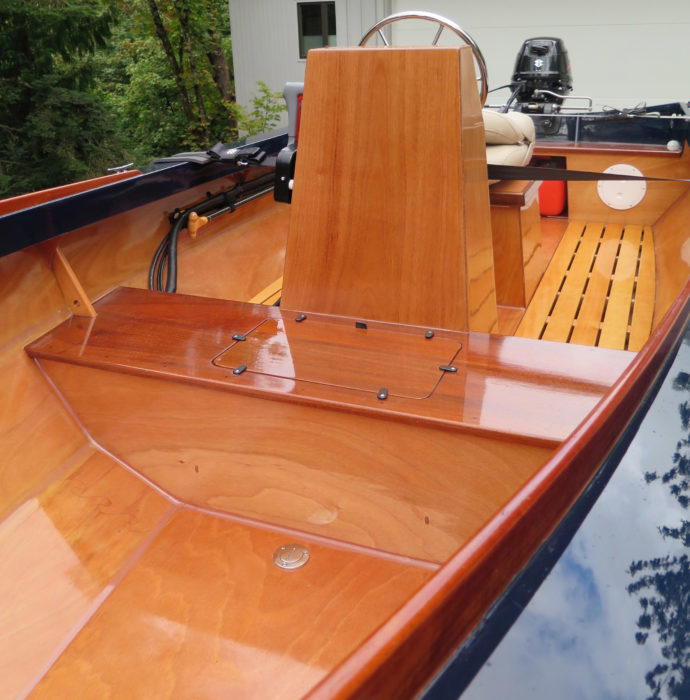
Mark replaced the kit’s plywood seat tops with solid sapele, cut them slightly oversize for a visually appealing overhang and wrapped the tops and bottoms with 4-oz ‘glass. The middle seat also has reinforcing gussets port and starboard where passengers are likely to step aboard.
On September 2 last year Mark and a friend launched in MOJO on the Willamette River. Less than 4 miles downriver Mark crossed the stern of a tug pushing a barge into a dock. MOJO, running light without her ballast tanks filled, got tossed around in the prop wash. Mark filled the tanks in mid-river, adding 320 lbs of ballast beneath the cockpit sole, and crossed the prop-wash again, this time with confidence-inspiring stability.
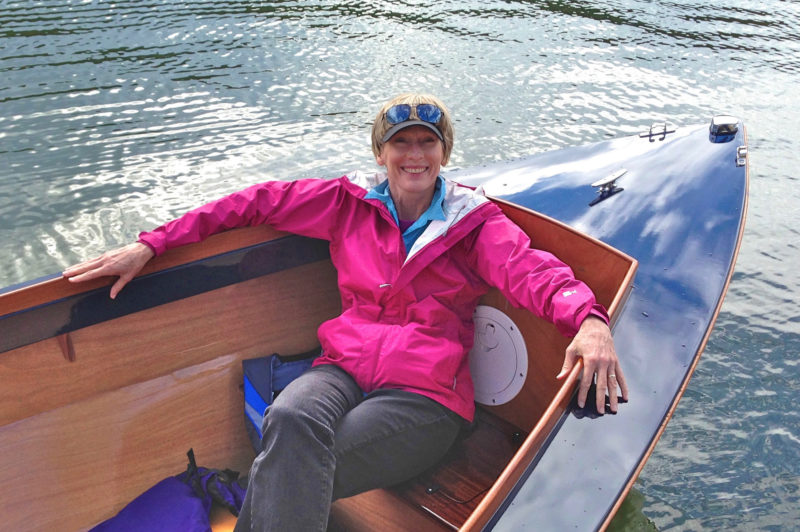
The forward bulkhead extends up behind the coaming, providing a comfortable backrest.
Meg joined Mark the following day for a 20-mile trip on the Willamette, and the following week the couple began the exploration that he’d been daydreaming about. They trailered north into Washington and toured Washington’s Hood Canal, and then launched again at Port Townsend to show the boat off at the Wooden Boat Festival.
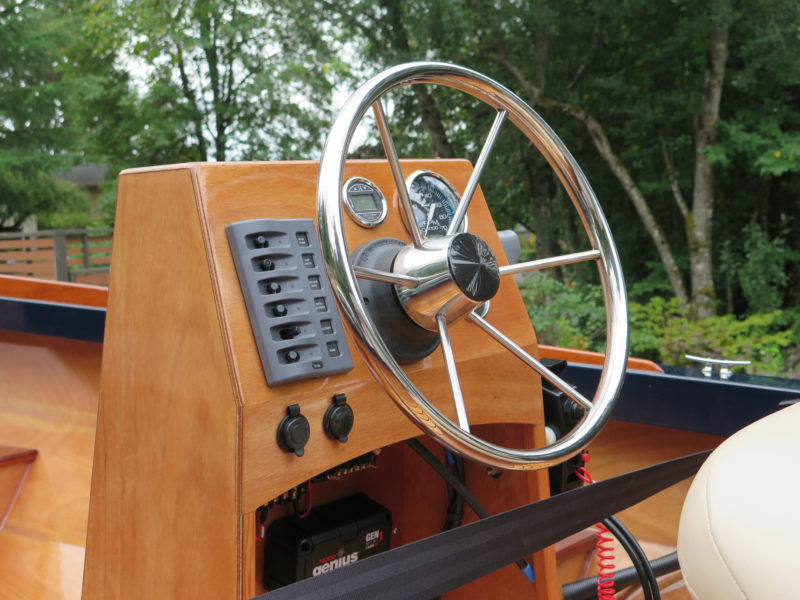
The instrumentation mark added to his PT Skiff includes tachometer, voltmeter and depth sounder with through-hull transducer. In the open space beneath the console he has an onboard 120-volt charger for charging the 55A/H AGM battery under middle seat.
Mark and MOJO made the most of the remaining mild autumn weather and explored more of the Willamette River both upriver and down, and ventured farther north to Multnomah Channel and the Columbia River. He reports that for MOJO running at 10–15 knots is “a lovely speed, not too much twitchiness, just a calm and mannered cruise.” On one of his outings he and a friend stopped at a riverside café. When they returned to MOJO, someone from the café asked if they were heading out soon, adding: “That boat is so damned beautiful, it’s making the rest of us look bad.”![]()
Have you recently launched a boat? Please email us. We’d like to hear about it and share your story with other Small Boats Monthly readers.
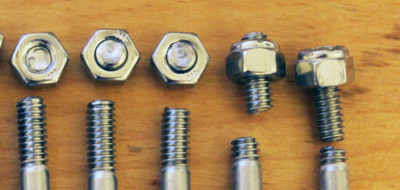
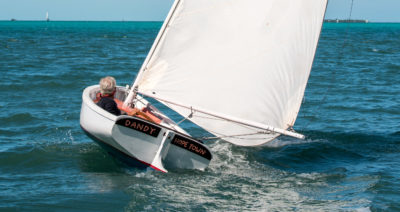
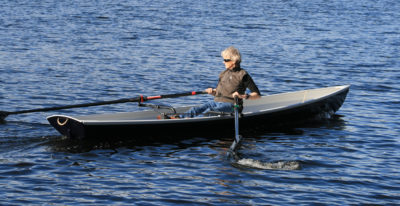
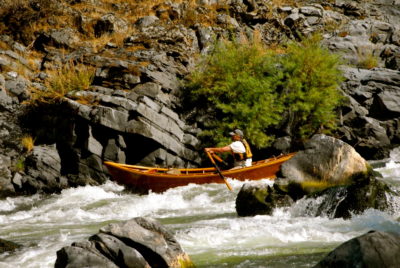
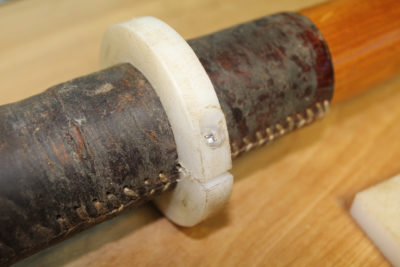
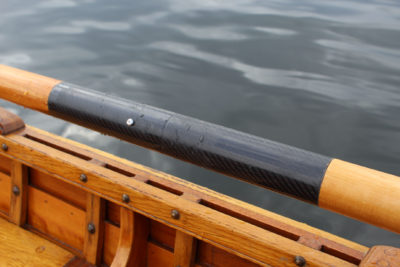
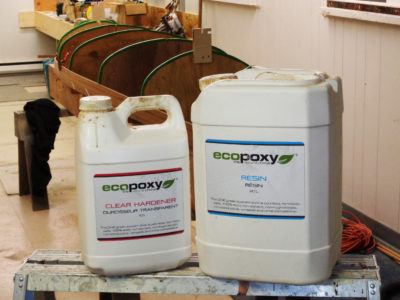
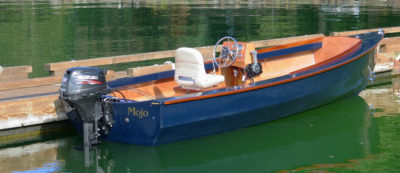
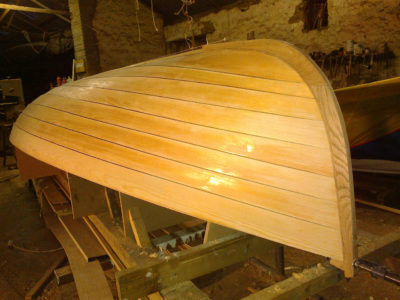

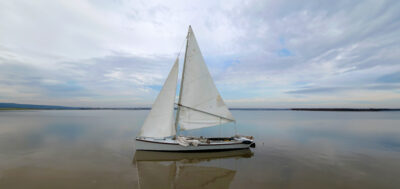
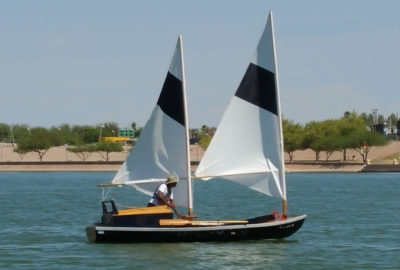
He is making us look bad. Nice work.
Ron, that’s a fact, that boat is very sweet.
Sure was nice to see the pretty lines come together into a fine-looking finished build of the Mojo. The only thing I’d ask about is the absence of an outside spray railing given the smooth topsides forward. It seems as though a breeze-driven afternoon chop, on the bow, might climb the topsides and wet the helm. A ½” or ¾” strip halfway up the stem would knock down that spray allowing the skiff to run past the wind swept salt water. I like to see the topsides’ sheer complimented by a long rail line, but it may be a personal taste item not widely shared. Nice job on the build, fine-looking design, great kit value for all who want this class of boat. I thought the several bilge flow treatments were particularly well thought out. Thanks again for posting her, Chris, and thanks to Mark for building such a sweet-looking skiff.
A really useful article, thanks for that. Such a sweet-looking build. Congratulations, Mark.
At 78, I’ve just started building wooden boats again, after a gap of 60 years. Although I’m a former shipwright, these days I’m a complete novice—to modern technology—which increases the fun of the challenge. So I pore over articles like these trying to soak up other folks’ experiences. When I launch my 15′ cedar-strip Maine lobster boat over here in West Wales, United Kingdom, I’ll let you know!
John, you are an inspiration! I may have another boat in me, still. I can’t wait to see your Maine lobster boat.
A good friend finished his PT Skiff a couple of years ago, a beautiful job similar to MOJO. His wife and two dogs frequent the Chesapeake Bay, NE, NY State, and south to Florida. And several times my wife and I have been invited on long runs and fun put-ins. It’s crazy how that 25-hp outboard pushes us along, all of us, dogs included, and there’s plenty of room. Wonderful boat!
I’m currently building one myself and I can’t WAIT until I get it in the water! This is an exceptional example of a PT Skiff and it shows beautifully.
Thank you, Jim. The nice thing about this project is that the resulting boat is very satisfying. You’ll have a lot of fun with her!
I am glad to see people building and enjoying “slow” boats. Here around Atlantic City, everyone wants the fastest thing on the water. Today I was watching the fishermen (the ones who fish for a living) going out in their skiffs to check their traps. A boat that can get up onto plane with a 25hp or so engine seems perfect for me. And I agree, Mojo looks absolutely perfect! I would be afraid to use her.
Mojo was built to be a fuel-efficient little runabout to have fun with. She was also built to be used. While not “absolutely perfect,” I did my best to make her very good and she is wearing well. We’ll see how it goes over a full season this year. (I may wish that I had painted some of the brightwork.)
Great work with lots of thought and looking good. It’s what attracted me to this issue and a subscription. Love anything boats as reflected in my web site of 10 years ago!
As a longtime WoodenBoat magazine subscriber, I decided to build a boat, and completed an 18′ Glen-L Tug Along. It has been one if my life’s most rewarding accomplishments. I recommend anyone thinking of building a boat to just go after it. You won’t be sorry.
Mark, did you paint her with Awlgrip?
Jim, it’s not Awlgrip. I decided to use a pro painter do the paint—the only thing that I didn’t do myself. Cody Thompson did the paint and he originally suggested rolled and tipped Awlgrip. Once he saw the hull, he suggested we use a sprayed two-part automotive finish with clear coat. The hull was very fair, so it made sense to him. It is easy to repair and really the only downside is that both the resin and the paint continue to cured, which thins both out. You start to see the weave of the glass in the finish. I had to cut it again and polish it out this season. I’ve nearly completed the process now: wet sanding to 2000 then ‘cutting’ (polishing) with 3 successive grits of polishing compound and a coat of wax. It sounds more difficult than it is. I also had to repair a couple of spots which are done the same way after touch up paint is applied.
If I were going to do the painting myself, I think it would either use Awlgrip or Perfection. I’m not sure, but I am thinking about building another boat. I may have to decide.
This whole “I think I’ll build another boat” is a sick obsession. I’m glad there’s a place we can all gather to feel “normal.”
I’ll probably roll and tip Awlgrip (vs Interlux), primarily for color choice. How do you like the Suzuki motor? What kind of performance are you getting? I’m considering their DF25A.
I am very happy with this engine. I chose the Suzuki based upon the recommendation of two separate dealers. I originally went shopping for a Honda. The big advantage is that it’s electronically fuel injected rather than using carburetors, so it deals with E10 fuel a lot better.
Once I got the prop right, Mojo does better than 20 knots with two aboard, and running at my preferred 10-15 knot cruise, it just sips fuel: 12 knots cruising at roughly 2/3 gal/hr. With 6 gallons in the tank, you can cover a lot of water and still have a good reserve.